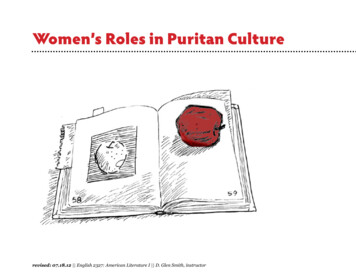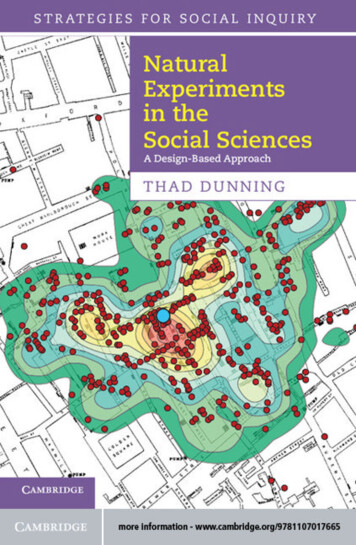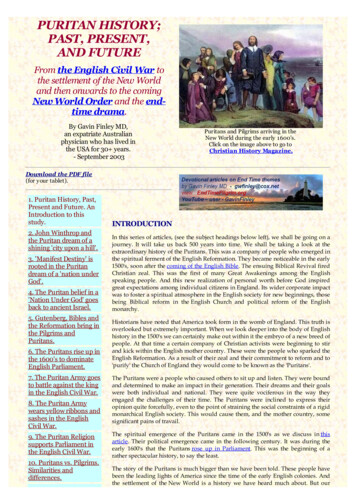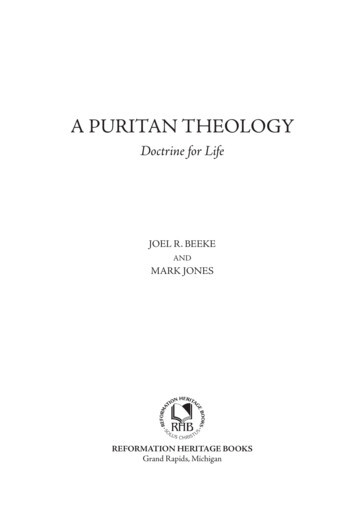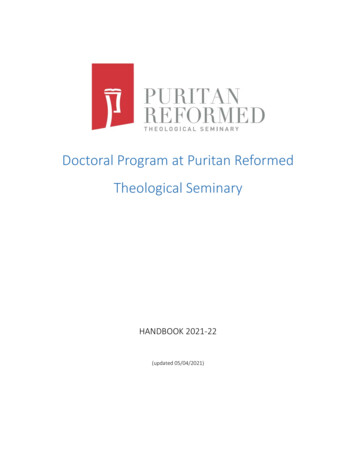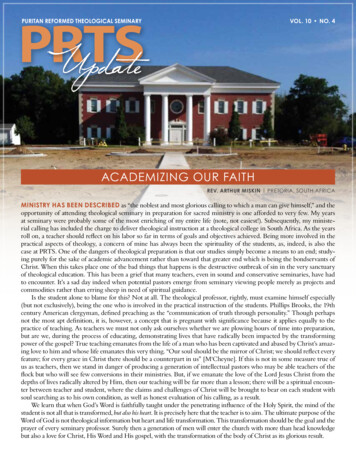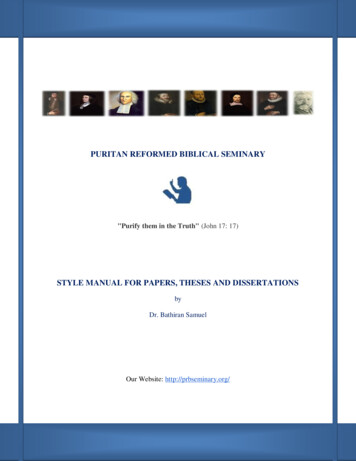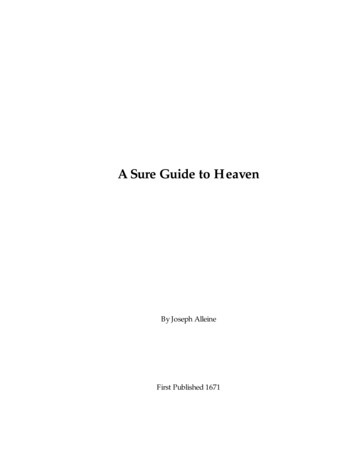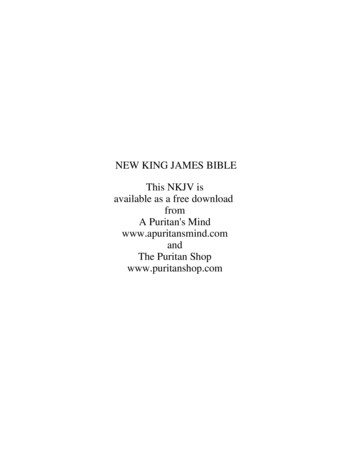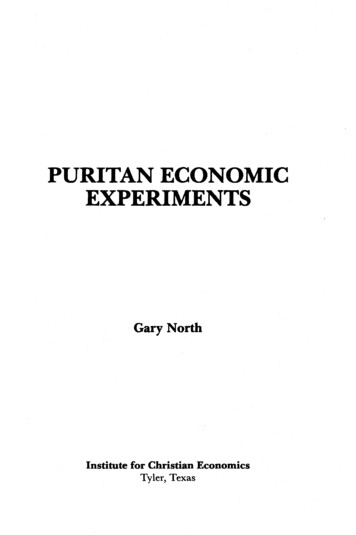
Transcription
PURITAN ECONOMICEXPERIMENTSGary NorthInstitute for Christian EconomicsTyler, Texas
Copyright 1988 by Gary NorthAll rights reserved. Written permission must be secured from thepublisher to use or reproduce any part of this book, except forbrief quotations in critical reviews or articles, or except asprovided by USA copyright law.Published in Tyler, Texasby the Institute for Christian EconomicsDistributed by Dominion Press, Fort Worth, TexasTypesetting by Nhung Pham NguyenPrinted in the United States of AmericaISBN 0-930464-14-1
This book is dedicated toPaul Poirotthe best editor I ever saw.
1111111111111111111111111111111111111111111111111
TABLE OF CONTENTSPreface.Introduction. . . . . . . . . . .1. Common Ownership.2. Price Controls. .3. Sumptuary Legislation.I52241SUBJECT INDEX . . . . . .63viiIX
PREFACEThe bulk of this little book appeared originally in a series ofthree articles in The Freeman in the spring of 1974. They, in turn,grew out of my doctoral dissertation, "The Concept of Propertyin Puritan New England, 1630-1720." The dissertation, exceptfor Chapter Two on medieval economics, has been publishedpiecemeal over the years. The chapters on New England's Puritan economic thought and practice appeared in The Journal ofChristian Reconstruction, Vol. V (Winter 1978-79) and Vol. VI.(Summer 1979 and Winter 1979-80). The dissertation's firstchapter, on biblical economics, appeared as Chapter Eighteenof An Introduction to Christian Economics (Craig Press, 1973), "AnOutline of Biblical Economic Thought." Finally, the dissertation's chapter on Max Weber appeared in The Journal of ChristianReconstruction, Vol. III (Summer 1976), as "The 'Protestant Ethic'Hypothesis." Thus, for any reader who becomes serious aboutpursuing some of the theological or economic issues raised in thisbook, the more detailed evidence is available, though no doubtout of date in terms of the latest findings, claims, and interpretations of professional historians. But who knows? Maybe theprofessionals are an wrong anyway. In any case, I think it isbetter to get this Inaterial hack into print than to wait until Ihave spare time to update it extensively. I have long given uphope of finding spare time to update old material extensively.There is too much new material to write.IX
INTRODUCTIONThis book is relatively simple. It covers three topics: thecommon ownership of land, the imposition of price and wagecontrols, and sumptuary legislation. The final topic is unfamiliarto most people. Three centuries ago, legislators believed that itwas the civil government's duty to enforce fashions. Sumptuarylaws were not aimed at public lewdness; rather, they were aimedat members of the lower class who wore clothing appropriate tothe upper class. The legislators recognized that clothing was(and usually is) symbolic of personal status within a socialhierarchy. They then jumped from the social hierarchy to thehierarchy of civil government. Rather than allowing marketforces (mainly income and expenditure restraints) to "keep thelower class in its place," they resorted to public coercion.By restricting this book to these three topics, 1 have donemybest to present the Puritan economic world-and-life view interms that can be readily grasped. I have also shown why theirattempts to enforce this economic worldview by resorting to thesword of civil government was based, not on biblical revelation,but rather on a specific inherited intellectual tradition: earlyscholasticism. While it may seem strange that Protestants asradical as the New England Puritans were in fact followers ofThomas Aquinas in the field of economics, there were reasonsfor it. First, they were not familiar with the later scholastic
2Puritan Economic Experimentstradition, which was much more free market oriented. l Second,tht; Puritans never fully broke with the theory of natural law, andit was the scholastics who had imported and baptized this humanist myth of ancient Greece and Rome. The Puritans did notattempt to rethink economics in terms of the Bible; instead, theysimply imported medieval scholastic economic categories intotheir legislation regarding pricing.Their land policies were governed by their desire to maintainthe tight control of the two local community institutions ofchurch and state. They believed that geography reinforces ethics.They designed each town to place the church at the center. Theydid what they could to restrict the spreading out of familiesacross the landscape. They kept large parts of the town incommons - areas that were supposed to substitute for the amassing of large privately owned tracts of land that would lead to thedispersal of families. They saw land hunger as an anti-socialforce. It was seen as a kind of centrifugal force that would leadto the atomization of the towns. They much preferred to spin offwhole new villages rather than spin off families one by one.The same sort of impulse was reflected in fashion, theybelieved. What was needed was hierarchy - a hierarchy thatwould be reflected in what people wore. Again, they fearedconfusion that is created by economic change, which inevitablyasserts itself in the form of social change. They saw hierarchy associal, political, and economic. They believed for half a centurythat they could preserve social hierarchy by means of the political hierarchy: restricting the economy by law.The period 1630-1720 was a period of great experimentation,an economic, social, and political laboratory in the New Englandwilderness. That experiment transformed the wilderness, and in1. Alejandro A. Chafuen, Christians for Freedom: Late-Scholastic Economics (SanFrancisco: Ignatius, 1986); Marjorie Grice-Hutchinson, The SChool of Salamanca:Readings in Spanish Monetary Theory, 1544-1605 (Oxford: The Clarendon Press, 1952);Murray N. Rothbard, "Late Medieval Origins of Free Market Economic Thought,"Journal of Christian Reconstruction, II (Summer 1975), pp.62-75.
Introduction3doing so, also transformed Puritanism. This had not been theintention of the founders, though it had always been their greatfear. 2 When Puritan optimism regarding New England's earthlyfuture began to fade after 1660, and then their economic experiments failed after King Philip's War in 1675-76, a new worldviewsteadily began to replace the older Puritanism, a combinationof pietism and natural law theory that still dominates Christiansocial thought. There is no better way to see how the Puritanworldview failed to meet the challenge, not of the wilderness butof prosperity, than to examine their three major economic experiments: government controls on land, prices, and fashions.2. Sacvan Bercovich, The American Jeremiad (Madison: University of WisconsinPress, ]978), ch. I.
1COMMON OWNERSHIPThe .experience that· was had in this common course and condition,tried sundry years, and that amongst godly and sober men, may wellevince the vanity of that conceit of Plato's and other ancients, applauded by some oflater times, that the taking away ofproperty, andbringing in community into a commonwealth, would make themhappy and jlourishing; as if they were wiser than God.William. Bradford 1One of the more familiar incidents in American history, atleast within conservative circles, is the disastrous experimentwith a common storehouse in the Pilgrim colony in 1621-23.Nearly half the· 102 passengers on the Mayjlower died of cold,sickness, and hunger during the first winter of 1620-21. 2 A firein January destroyed the common storehouse and some of theirmeager supplies. 3 In the fall, a second ship, the Fortune, arrivedwith 36 poverty-stricken settlers. Those already settled in Plymouth had to provide for them. The colonists went on halfrations. Governor Bradford warned that this new burden would1. William Bradford, "History 'OfPlimoth Plantation,'" in]oseph Allan Montgomery (ed.), Christian History oj the Constitution of the United States of America (SanFrancisco: American Christian Constitution Press, 1960), p. 213. Compiled byVerna Hall. I have modernized the spelling.2. George D. Langdon, Jr., Pilgrim Colony: A History of New Plymouth, 1620-1691(New Haven, Connecticut: Yale University Press, 1966), p. 14.3. Idem.5
6Puritan Economic Experimentsthreaten the colony with famine. In the spring of 1622, thisprophecy came true. 4The Common StorehouseWhat is perhaps the Pilgrims' second-best-known historicalincident after the thanksgiving feast is the disastrous experimentwith common ownership. Everyone was required to bring allthat he had produced into the common storehouse, and to eachfamily was rationed out the supplies deemed appropriate to itssize. It was a classic experiment with the Communist principleannounced by Karl Marx: "From each according to his ability,to each according to his needs!"5 It did not work. It intensifiedthe famine. Governor Bradford describes in some detail in hishistory of the colony how young men refused to work in thecommon fields.For this community [of property-C.N.] (so far as it was) was foundto breed much confusion and discontent, and retard much employmentthat would have been to their benefit and comfort. For the young menthat were most able and fit for labor and service did repine that theyshould spend their time and strength to work for other men's wives andchildren, without any recompense. The strong, or man of parts, hadno more in the division of victuals and clothes than he that was weakand not able to do a quarter the other could; this was thought injustice.The aged and graver men to be ranked and equalized in labors, andvictuals, and clothes, etc., with the meaner and younger sort, thoughtit some indignity a d disrespect unto them. And for men's wives to becommanded to do service for other men, as dressing their meat, washing their clothes, etc., they deemed it a kind of slavery, neither couldmany husbands wen brook it. 6Upon petition of the planters in 1623, the Governor and his4. Ibid., p. 17.5. Karl Marx, "Critique of the Gotha Program" (1875), in Karl Marx andFrederick Engels, Selected Works, 3 vols. (Moscow: Progress Publishers, 1970), III,p.19.6. Bradford's "History," op. cit' p. 213.j
Common Ownership7council decided to follow their advice: to assign families theirpersonal plots offarm land (according to family size) and abolishthe common storehouse. Only the tools of the colony were heldin common, and land could not be conveyed (initially) by inheritance. 7 Immediately, men and women returned to the harvestfields. Bradford writes: "By this time harvest was come, andinstead of famine, now God gave them plenty, and the face ofthings was changed, to the rejoicing of the hearts of many, forwhich they blessed God. And the effect of their particular planting was well seen, for all had, one way and other, pretty well tobring the year about, and some of the abler sort and moreindustrious had to spare, and sell to others, so as any generalwant or famine hath not been amongst them since to thisday."8Later, the restriction against deeding land to children was abolished.An Imposed DecisionWhat is less known about this incident is how the littlecolony ever made such a disastrous decision in the first place.The fact of the matter is that the colonists had never wanted toinaugurate a system of totally common storehouse. The groupof British "adventurers" that had supplied the Pilgrim exiles inHolland with traveling money and capital had insisted that thecolony be made a part of the joint-stock company. The assets ofthe colony were therefore the assets of the company, headquartered in Britain, and the agricultural products were to be sharedequally among company members, both colonial and British.Governor Bradford was the chief agent of the company in NewEngland; hence, he was compelled to impose the common storehouse system. 9In the original negotiations, it had been understood that7. Langdon, Pilgrim Colony, p. 29.8. Bradford, op. cit., p. 217.9. Andrew Lane, "The Pilgrim Fathers were· never socialists: An historicalreflection," Review ofthe News (Nov. 24, 1976), pp. 35-50.
8Puritan Economic Experimentsprofits would be shared by all members of the company, but thecolonists had not agreed to the sharing of houses, gardens, andother improved land. They were informed of these terms onlyas they were about to leave for North America, and as they left,they sent back word to the merchant adventurers that theiragents who had agreed to such terms had not been empoweredto do so.lOBut the continuing dependence upon the company forresources during the first year of the colony's existence compelledthem to givein to the company's terms. llThe story did not end in 1623, when necessity forced thehands of the colonists. In 1627, the bickering British directorssold out their interests in the colony to the settlers for 1800pounds. The settlers were to spend a decade and a half in payingoff their debt, and at times had to borrow extra time at rates of30 percent to 50 percent. Nevertheless, they persisted and finallyrepaid the debt, in 1642.In 1627, shortly after buying out the British directors, Governor Bradford supervised the division of the colony's assets amongthe settlers. First, they divided livestock. There were few animals, so the 156 people (fewer than 40 families) were divided intoa dozen companies; each company received a cow and two goats.In January of 1628, the land was divided, this time by randomlot. Complaints about unequal housing were forestalled by requiring those who received better housing to make an equalizingpayment to those receiving poorer housing. Peace was preserved.There was one decision, however, which was to prove costly.Meadow was in short supply, so it was kept in common ownership. Furthermore, fishing, fowling, and water remained "open"to all· settlers. 12 The Pilgrims were to have the same difficultieswith the administration of these common fields as their neighbors, the Puritans, were to experience. Only after 1675, when thecommons throughout New England were increasingly distrib10. Langdon, Pilgrim Colony, p. 9.11: Ibid., p. 26.12. Ibid., p. 31.
Common Ownership9uted to the families in each town, were these problems overcome.Varying Concepts of OwnershipIn order to understand the thinking of the first half centuryof New England's settlers, we have to realize that these immigrants did not bring over from England some universally accepted concept of land ownership. There was an obvious tendency for groups of settlers from one region in England to establish homogeneous townships in Massachusetts. English townshad developed at least three major systems of land tenure: theopen field system, the closed field system, and the incorporatedborough. All three appeared in New England in the early years.The open field system stressed the community administration of land. It is this system which we generally associate withthe word "medieval," al though the Middle Ages saw manysystems of land tenure. Sumner Chilton Powell has describedthese systems in some detail in his Pulitzer Prize-winning study,Puritan Village. The open field system "regarded the advantagesof the area as communal property, to be shared by all. No onewas- to exclude a neighbor from such a necessity as good meadow,or the down, or the woods. And if anyone practiced such exclusion, or attempted to increase the amount of his holding at theexpense of his neighbors, all villagers reacted instantly to restor their 'rights."Q3 Needless to say, this approach did not survivelong in the setting of New England.Quite different was an English borough like Berkhamsted.In the early seventeenth century, over one thousand acres "wereopened up, bought, or traded, in countless individual transactions. If the men of Berkhamsted were doing nothing else, theywere trading land."14 The legend of the Yankee trader wasrooted in this sort of English inheritance. There were someenclosed lands, but most of the farmers were shifting as rapidly13. Sumner Chilton Powell, Puritan Village: The pormation of a New England 7bwn(Garden City, New York: Doubleday Anchor, [1963] 1966), p. I J.14. Ibid., p. 26.
10Puritan Economic Experimentsas possible to a system of individual farm management.A third system was a sort of combination, the closed fieldsystem of East Anglia. "There was one common pasture, buteach farmer was expected to provide a balance of arable pastureand hay meadow for himself. He succeeded, or failed on his ownfarming ability."15 One of the problems in a Massachusetts townlike Sudbury was the diversity of backgrounds of its inhabitants.There was no agreement as to where the locus of economicsovereignty should be. Should it be the individual farmer? Shouldit be the town's selectmen who controlled the resources of thetown commons?Tightly Knit CommunitiesThe towns and colonial governments of seventeenth-centuryNew England were not strictly theocracies; ordained ministerscould not be elected to political office. But they were importantas advisers. Furthermore, the laymen of that era were very oftenmore theologically motivated than ministers of this century.Most of the towns were regarded as tightly knit Christian commonwealths by their inhabitants, and during the first fifty yearsof their existence, they imposed restrictions on immigration intothe local community. They were concerned that newcomersmight not meet the religious and moral standards of the presentinhabitants. As late as 1678, the records of Plymouth Colonyoffered the hope that "the Court will be careful, that whom theyaccept are persons orthodox in their judgments." The Puritantowns of Boston, Cambridge, Dedham, and probably many others all included the requirement that outsiders be cleared bytown officials before they were allowed to buy land locally.Braintree even included a restriction on land sales (though notexplicitly religious in intent) that local residents would have theright to bid first on all property offered for sale to outsiders.It is significant that in the final quarter of the century, these·religious restrictions were generally dropped. Instead, a new15. Ibid., p. 72
Common Ownership11requirem.ent - in fact, a new emphasis on an old requirement- appeared: restrictions on immigrants who might become aburden on the welfare rolls. The towns had steadily becomemore pluralistic theologically, but the fear of an increase in taxrates was a truly ecumenical device. By offering economic support to local indigents, the townspeople were afraid that outsiders might take advantage of this legal charity. Barriers to entryfollowed in the wake of "free" goods, however modest - andthey were very modest - the size of the public welfare allotments. 16Pressure on the CommonsThe fear of increased welfare burdens was not the onlyeconomic issue confronting established communities every timea stranger sought admission as a resident of some town. In theearly years of settlement, each town had considerable land - sixto eight miles square, meaning anywhere from 30,000 to 40,000acres - and relatively few inhabitants. Each resident had legalaccess to the common pasturage and to any future divisions ofland from the huge blocs owned by the town. But as the numberof inhabitants increased, and as more and more distributions oftown land reduced the available source of unowned land, the percapita supply of land began to shrink. Those inhabitants whohad a share in the common pasture and the common landssought to protect their control over further use and distributionsof such property. In. town after town, a new rule was imposed:outsiders had to purchase access to rights in the common property from local inhabitants. The result was a new appreciationof private ownership and private control of property, even amongmen who had grown up in English communities that had usedthe open field system of farming. The land hunger of NewEngland after 1650 created new incentives to gain and exercise16. On the size of local town charities, see Stephen Foster, Their Solitary Way:The Puritan Social Ethic in the First Century of Settlement in New England (New Haven,Connecticut: Yale University Press, 1971), p. 137.
12Puritan Economic Experimentspersonal sovereignty over the chief economic resource, land.There was another incentive to reduce the size of the community-owned property: bureaucratic wrangling. Page after pageof the Massachusetts town records, year after year: how torestrain access to the common meadow? How to keep midnightvisitors from cutting down choice trees for. firewood or otheruses? How to keep the meadow's fences in repair? Statute followed statute, to no avail. Fines were imposed, equally to noavail. "Free" land meant strong demand for its productivity,andtown leaders never were able to find a rational, efficient meansof restricting uneconomic uses of the town property. Men had astrong incentive to further their personal economic ends, and farless incentive to consider the public's position. The commonsserved as incentive to waste, for without a free market andprivate ownership, it was impossible to calculate accurately thecosts and benefits associated with the use of the land. This is thechief economic flaw of all socialist systems, and the early settlersof New England were. unable to solve it.The Continuing Problem ofSupply and DemandSomeone who has only a superficial knowledge of the historyof the Puritans of the Massachusetts Bay Colony tends to seethem as men obsessed with imposing religious restraints or moralrestraints on private activities. They were concerned with suchquestions, as the records indicate, but from the bulk of thelegislation, two problems were eternal, unsolvable, and endlesslybothersome to Puritan leaders: 1) pigs without rings in theirnoses running through the town, and 2) midnight tree cutterson the commons. The tree cutters, like the pigs, insisted onsticking their noses into other people's property.The commoners - those who had legal access to the common fields and meadows - were too often involved in whattoday is known as "free riding." They planted crops in thecommon property, but neglected to keep their portion of thecommons properly fenced. It was almost impossible to keep trackof who was responsible for which plot. The town had to intervene
Common Ownership13and assign plots, thus creating opportunities for local politicaldissension. Animals that wandered around the fenced land oftenbroke down unrepaired fencing between plots, getting into someone else's crops. Tension here was continual.Fencing inspectors were important officials in every town.Conflicts over responsibility were endless. Without private plotsprivately repaired, such conflicts were inevitable. In the earlydecades of Massachusetts, no single public policy prevailed long.First, the colony's General Court - the chief legislative agency- placed the responsibility for fencing on the local town; then itplaced the responsibility on the local individual citizen; next itswitched back to its original position of town control. The statutes did not function well in practice. Different communities haddifferent problems, and the central government had difficulty indealing with all of them through the use ofany single administrative policy. 17The Tragedy ofthe. CommonsThe problem facing every selectman in every New Englandvillage was the tragedy of the commons, as the biologist GarrettHardin has called it. Each person who has access to the benefitsof public property for use in his own personal business has apositive incentive to drain additional resources from the commons, and he has a very low or even negative incentive torestrain him. The cost ofhis actions are borne by all the "owners," while the benefits are strictly individual. One more cow orsheep or goat grazing on the town commons will register nonoticeable increase in the communally assessed economic burdenwhich rests on any single individual. Yet such grazing is immediately beneficial to the owner of the animal. High benefits, lowcosts: "Each man is locked into a system that compels him to17. William B. Weeden, Economic and Social History of New England, 1620-1789, 2vols. (New York: Hillary House, [1890] 1963), I, pp. 59-60.
14Puritan Economic Experimentsincrease his herd without limit - in a world that is limited."18I t is not surprising that selectmen would find themselves burdened with endless disputes concerning the size of the local herdsand the proper - "fair" - assessments of the economic costs ofrunning those herds on the commons.There is an answer to the tragedy of the commons, at .leastwhere it is inexpensive to assign property rights. As C. R. Battenhas argued, the transfer of ownership from an amorphous· common group to iridividual citizens provides an incentive to reducethe demands made on the land. Private owners have to assessboth costs and benefits of any activity, seeing to it that costs donot outrun benefits. 19 By the end of the seventeenth century,Puritan leaders - or at least leaders who were the descendantsof Puritans - reached a similar conclusion.The Multiplication ofLegislationWith each piece of legislation, another set of problems appeared. First, only actual town commoners could run their animals in the common meadow or in the outlying common lands.Only local residents could cut the trees. Later, the selectmen hadto impose limits on the number of cattle that could be run,frequently on a "one cow per man" rule. Each man was assesseda few shillings per year for this right. Some people brought inhorses; Boston banned them on Sundays. Sheep had to be supervised by a sheep herder. As more animals required full-timesupervision, towns hired herdsmen. To keep the cost-per-beastlow, each town resident was required by law to run his animalwith the herd. Cambridge, for example, imposed a fine of oneshilling on anyone whose cow was found on his land after 8 a.m.Since the driver left at 6 a.m., anyone who had not yet deliveredhis animal to the herd had to escort his cow to the driver, eating18. Hardin, "The Tragedy of the Commons," Science (13 Dec., 1968); reprintedin Garrett de Bell (ed.), The Environmental Handbook (New York: Ballantine, 1970),p.37.19. C. R. Batten, "The Tragedy of the Commons," The Freeman (Oct. 1970).
Common Ownership15up scarce time. A similar law for goats was passed two yearslater, in 1639. 20 People naturally attempted to evade the law, andby 1648 the revenues supporting the town's herdsman were notmeeting his salary. Consequently, in typical interventionist fashion, the selectmen. decided to. assess all men a certain amount,whether or not they ran cattle on the commons. 21 A similar rlliewas established in Watertown in 1665, and the massive evasionsencouraged the selectmen to pass an even stifTer law in 1670. 22Corrected Over TimeThe confusion reigned for decades. As the Watertown re cords report so eloquently, "there being many complaints madeconcerning the disorderliness of cattle and swine and the multitudes of sheep in the town, it was voted that the matter abovementioned is left with the selectmen to consider something thatmay tend to reformation and to present what they shall do to thetown to be confirmed."23 Needless. to say, the selectmen couldnot do anything about it, any more than half a century ofPuritantown governments before them. The only solution was the distri bution of the commons to local inhabitants - the demise of thecommons.Traditional patterns of life do not die out overnight. Men areusually unwilling to change their way of life unless forced to doso, either by economic circumstances or by direct political pressure. The little town of Sudbury was a case in question. Itsinhabitants clung to the old English system of communal prop"erty management. The access to the commons was restricted in1655, and at least thirty younger men received no meadowgrants for their animals. They went out ofthe selectmen's meeting ready to fight. Fight they did, until the town was split. They20. The Records ofthe TOwn ofCambridge, Massachusetts, 1630-1703 U90 I), pp. 28, 39.2I.lbid., p. 72.22. Watertown Records (1894), I, pp. 92, 94-95.23. Ibid., p. 142.
16Puritan Economic Experimentsformed a new community down the road, Marlborough. Notgaining access to the local commons, they were perfectly willingto settle for a 24,OOO-acre plot a few miles away.24Factional strife was not a part of the original goals of thefounders of New England. Factionalism was a blight to be avoided;this opinion remained a touchstone of American political thoughtright down to]ames Madison's Federalist #10. Yet the quarrelingover the commons was incessant, in direct opposition to thepolitical and communal ideal of the peaceable kingdom."Togetherness"The town of Sudbury was not to be the only Puritan villageunable to cope successfully with the centrifugal forces createdby the presence of socialized property within the town limits.The creation of Marlborough, despite the fact that the youngfounders also established a town commons, testified to the difficulty of preserving both the old common field tenure system andsocial peace in the midst of vast stretches of unoccupied land. Itwas too easy to move out, and this feature of New England wasto erode the medievalism of early Puritan thought. The centralized social control necessary to enforce such a system of commonland required the existence of widespread land scarcity. Ironically, it was in the final quarter of the seventeenth century thatsuch land scarcity appeared - scarcity of the most productivelands - but by that time the haggling over the administrationof the commons and increasing land values had already providedthe incentives necessary to convince both leaders and averagecitizens that the commons should be distributed permanently.One of the original goals of the founders of New Englandwas that of social cohesion. The life of each community was tobe religiously based. The ch
for Chapter Two on medieval economics, has been published piecemeal over the years. The chapters on New England'sPuri tan economic thought and practice appeared in The Journal of Christian Reconstruction, Vol. V (Winter 1978-79) and Vol. VI.(Summer 1979 and Winter 1979-80). The dissertation's first
